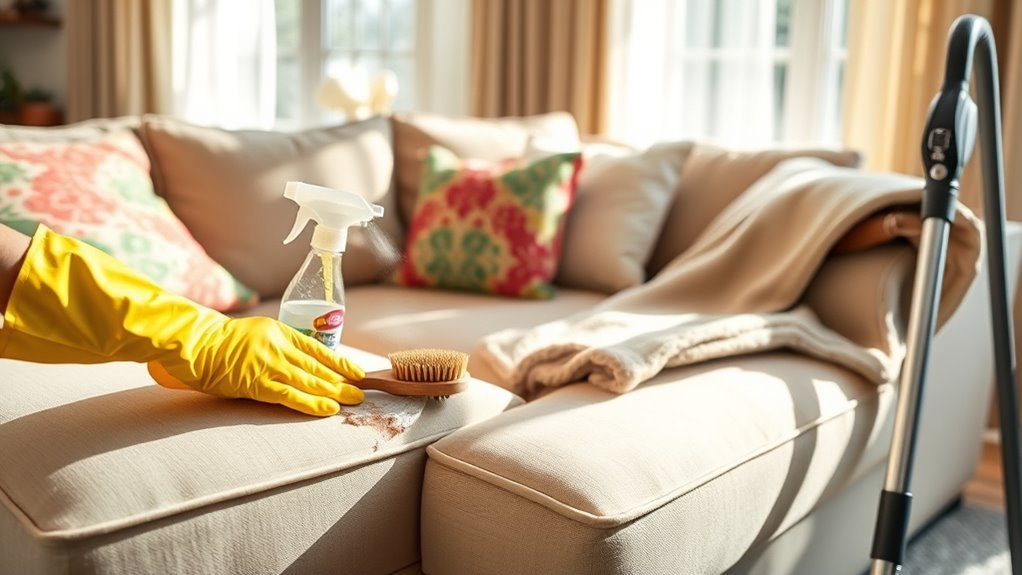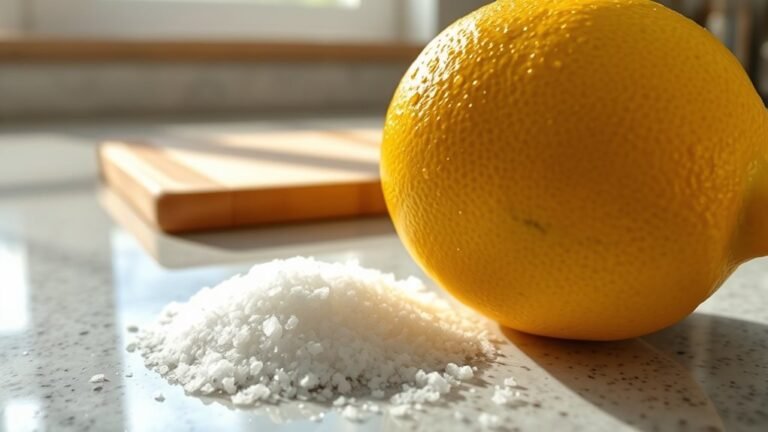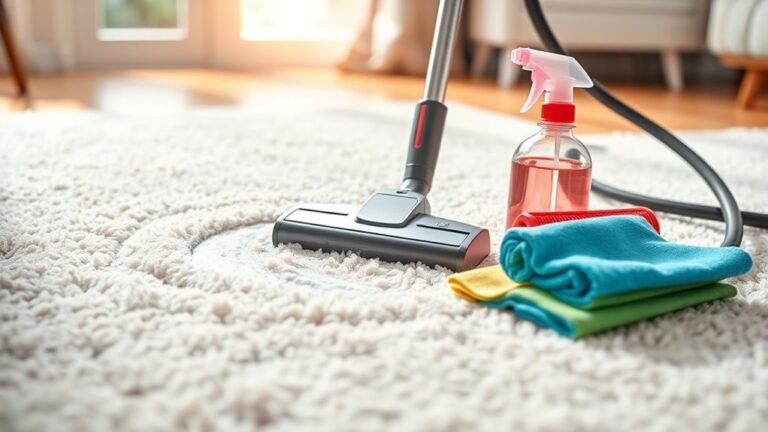Cleaning Techniques for Couch Owners
You’ll want to start by identifying your couch’s material since cotton, leather, and microfiber need different care methods. Use a vacuum with upholstery attachments and soft brushes to remove dust regularly. Spot clean stains immediately using mild detergents or special cleaners suited for your fabric. For leather, condition weekly to prevent cracks. Regular maintenance, like steam cleaning and protective covers, keeps your couch fresh and extends its life. There’s more to discover about stain removal and fabric-specific tips ahead.
Understanding Different Couch Materials

Before you start cleaning your couch, it’s important to understand the material it’s made from, as different fabrics and leathers require specific care methods. Cotton blends, for example, are durable but prone to shrinking or fading if exposed to harsh chemicals or excessive water. You’ll want to use mild detergents and avoid soaking the fabric. Synthetic fibers, such as polyester or nylon, are generally more resistant to stains and easier to clean, but they can react poorly to high heat or abrasive scrubbing. Knowing your couch’s material lets you choose the right cleaning approach, preserving its look and feel. This knowledge empowers you to maintain your freedom to enjoy a fresh, comfortable space without risking damage or costly repairs.
Essential Tools for Couch Cleaning
Although knowing your couch material is essential, having the right tools is just as important to achieve effective cleaning results. For couch maintenance, start with a vacuum cleaner equipped with upholstery attachments; it removes dust and debris without damaging fabric. Next, keep a soft-bristle brush handy to gently loosen dirt from delicate surfaces. Microfiber cloths are perfect for wiping down leather or synthetic materials without scratching. You’ll also want a spray bottle for applying cleaning solutions evenly. Finally, consider investing in a handheld steamer to sanitize and refresh your couch without harsh chemicals. Using these cleaning tools methodically guarantees your couch stays in great shape, giving you the freedom to enjoy a fresh, inviting living space without hassle or damage.
Spot Cleaning Common Stains

With the right tools in hand, tackling stains on your couch becomes much more manageable. First, identify the stain types—common ones include food, ink, and pet accidents. Each requires a specific approach: blot fresh spills immediately with a clean cloth to prevent setting. For food stains, use a mild detergent solution; for ink, apply rubbing alcohol sparingly; pet stains benefit from enzymatic cleaners. Remember, spot cleaning should correspond with your cleaning frequency to avoid buildup. Don’t overdo it; treat stains promptly but avoid saturating the fabric. Test any cleaner on a hidden area first. By addressing stains methodically and promptly, you maintain your couch’s appearance and extend its life, giving you more freedom to enjoy your space without worry.
Deep Cleaning Fabric Upholstery
When it’s time for a deep clean, you’ll want to focus on effective stain removal methods tailored to your fabric type. Using a steam cleaner can help lift dirt and kill bacteria without harsh chemicals. Let’s explore how these techniques can refresh your upholstery thoroughly.
Stain Removal Methods
There are several effective stain removal methods you can use to deep clean fabric upholstery and restore your couch’s appearance. Start with general stain removal by blotting spills immediately with a clean cloth to prevent setting. Use a mild detergent mixed with water for most stains, applying gently and avoiding over-saturation. For specific stain techniques, tailor your approach: use vinegar and baking soda for odor and mildew, rubbing alcohol for ink, and a paste of baking soda and water for grease. Always test any solution on a hidden area first to verify it won’t damage the fabric. By combining these general and specific stain removal strategies, you’ll maintain your couch’s look and enjoy the freedom of a clean, fresh living space.
Steam Cleaning Benefits
Although regular cleaning can remove surface dirt, steam cleaning offers a deeper level of fabric care that reaches embedded grime and allergens. When you use steam cleaning on your couch, high-temperature vapor penetrates deep into the upholstery fibers, effectively loosening dirt and killing bacteria, dust mites, and mold spores. This method doesn’t rely on harsh chemicals, making it safer for you and your family. Beyond just appearance, steam cleaning improves indoor air quality by reducing allergens that can trigger respiratory issues. The health benefits alone make it worth incorporating into your routine. Plus, steam cleaning helps maintain your couch’s fabric integrity, extending its lifespan and keeping it fresh. If you want a thorough, eco-friendly way to clean, steam cleaning delivers reliable, deep results that support your well-being and freedom from allergens.
Caring for Leather Couches

Because leather is a natural material, it requires specific care to maintain its appearance and durability. You’ll want to focus on regular leather conditioning to prevent drying and cracking. For minor damage, scratch repair kits can restore the surface without professional help. Keep your couch away from direct sunlight to avoid fading.
| Task | Frequency | Tools Needed |
|---|---|---|
| Leather Conditioning | Every 6 months | Leather conditioner |
| Dusting | Weekly | Soft cloth |
| Scratch Repair | As needed | Repair kit |
Maintaining Microfiber Sofas
When it comes to maintaining microfiber sofas, quick spot cleaning is essential to keep stains from setting. You’ll want to use gentle, water-based solutions to avoid damaging the fabric’s texture. Also, prevent fabric damage by avoiding harsh scrubbing and keeping sharp objects away from the surface.
Spot Cleaning Tips
Spot cleaning microfiber sofas effectively requires using the right tools and techniques to prevent damage. You should address stains promptly to maintain your sofa’s appearance and extend its life. Regular cleaning frequency helps with stain prevention, reducing buildup that can set stubborn marks. Use a gentle cleaner suited for microfiber and a soft cloth to blot — never rub. Test any cleaner in an inconspicuous area first.
| Stain Type | Recommended Cleaner | Action Steps |
|---|---|---|
| Food & Drink | Mild soap solution | Blot gently, rinse, air dry |
| Ink | Rubbing alcohol | Dab carefully, avoid excess |
| Grease | Dish soap mix | Blot, then wipe with water |
| Pet Stains | Enzyme cleaner | Apply, wait, blot dry |
Preventing Fabric Damage
Although microfiber is durable, preventing fabric damage requires consistent care and mindful use. To protect your sofa, avoid placing sharp objects or heavy items on it, as these can cause tears or distort the fabric’s texture. Stick to a regular cleaning frequency—vacuum weekly to remove dirt and dust that wear down the fibers over time. When you clean, always use gentle, microfiber-specific products to maintain fabric integrity. Avoid harsh chemicals and excessive moisture, which can weaken or stain the material. Rotate cushions frequently to distribute wear evenly, and keep your sofa out of direct sunlight to prevent fading. By following these fabric care steps, you’ll extend your microfiber sofa’s life while enjoying the freedom of a clean, comfortable space.
Removing Pet Hair Effectively
Because pet hair tends to cling stubbornly to couch fabric, removing it effectively requires the right tools and techniques. Start by regularly using a lint roller or a rubber glove to lift fur from the surface. You can also dampen a microfiber cloth slightly and swipe it over the fabric to gather hair more efficiently. Incorporate pet grooming into your routine to reduce shedding at the source, which makes fur removal easier. Vacuum your couch with a brush attachment designed for pet hair, ensuring you cover all crevices. For tougher spots, a pet hair remover brush with rubber bristles can work wonders. By combining these steps, you’ll keep your couch free of pet hair, maintaining a clean, comfortable space without feeling restricted by constant cleaning.
Preventative Measures to Keep Your Couch Clean
Keeping your couch free of pet hair is a great start, but preventing dirt and stains from settling in will save you even more effort in the long run. One effective way is to use couch covers. These protect your furniture from spills, dirt, and pet hair, making cleanup faster and easier. Choose covers that are easy to remove and machine washable for convenience. Establishing cleaning schedules is equally important. Set weekly reminders to vacuum your couch and monthly alerts to wash covers or spot clean. Consistency keeps your couch looking fresh and extends its lifespan. By combining couch covers with regular cleaning schedules, you maintain a cleaner, more inviting living space while freeing yourself from extensive deep cleans. This methodical approach keeps your couch in top shape with minimal hassle.
Choosing the Right Cleaning Products
When selecting cleaning products for your couch, it is vital to take into account the fabric type and any manufacturer recommendations. Different materials respond uniquely, so using fabric safe cleaners designed specifically for your couch guarantees you avoid damage. Opting for eco friendly products not only protects your couch but also reduces environmental impact, aligning with a desire for healthier living spaces. Before applying any cleaner, test it on a hidden spot to check for colorfastness or adverse reactions. Stick to products labeled for upholstery or fabric use, and avoid harsh chemicals that can degrade fibers. By choosing the right cleaning products methodically, you maintain your couch’s appearance and longevity while enjoying freedom from worries about harmful effects.
Häufig gestellte Fragen
How Often Should I Rotate Couch Cushions?
How often do you think about cushion maintenance? To keep your couch comfy and your upholstery longevity intact, you should rotate your cushions every one to two weeks. This simple habit prevents uneven wear and sagging, ensuring your sofa stays inviting and supportive. By regularly flipping and rotating cushions, you’re not just maintaining comfort—you’re extending your freedom to lounge without worry for years to come.
Can Couch Cleaning Improve Indoor Air Quality?
Absolutely, couch cleaning can improve indoor air quality by reducing couch allergens like dust mites, pet dander, and mold trapped in your upholstery. When you regularly perform upholstery maintenance—vacuuming, spot cleaning, and deep cleaning—you lower these irritants, which can otherwise circulate in your home. Keeping your couch clean not only freshens your space but also helps you breathe easier, supporting a healthier, freer living environment.
What Are Eco-Friendly Alternatives to Commercial Couch Cleaners?
If you want a natural way to freshen your couch, try a vinegar solution combined with baking soda. Imagine Sarah, who swapped harsh chemicals for this mix—she sprinkled baking soda to absorb odors, then sprayed a diluted vinegar solution to lift stains. It’s eco-friendly, affordable, and easy. You’ll enjoy a cleaner couch without harmful residues, letting you breathe freer and live greener. This simple method respects your space and the planet.
How to Handle Couch Frame Repairs?
When handling couch frame repairs, first assess frame stability by checking for loose or broken joints. Use quality repair materials like wood glue, screws, or brackets to reinforce weak spots. Disassemble damaged parts carefully, then reattach or replace them as needed. Tighten connections to guarantee the frame supports your couch properly. Taking these steps gives you freedom from worry and extends your couch’s life efficiently and effectively.
Are Couch Covers Effective for Protecting Upholstery?
Couch covers are quite effective for protecting your upholstery, especially when you choose the right couch cover materials like polyester or microfiber. These fabrics offer excellent stain resistance, helping keep spills and dirt at bay. Plus, covers give you the freedom to switch styles or clean easily without risking damage to your couch. Just make sure the cover fits well to avoid slipping and maximize protection.






